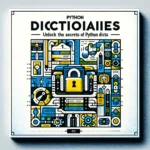Python is a versatile and high-level programming language that is used for a wide range of applications. One of the most important data structures in Python is the tuple. In this article, we will discuss the concept of tuples in Python, how to create them, and various operations that can be performed on them.
What are Python Tuple?
A tuple is an immutable, ordered collection of items, which can be of different data types. Unlike lists, tuples are fixed in size and cannot be changed once created. This makes them more suitable for situations where data should not be modified. In Python, tuples are defined using round brackets “()” and the items are separated by commas.
Creating a Tuple in Python
To create a tuple in Python, simply enclose the items you want to include in the tuple within round brackets and separate them with commas. For example:
# Creating a tuple with different data types
my_tuple = (1, "Hello", 3.14, True)
print(my_tuple)
# Output: (1, "Hello", 3.14, True)It is also possible to create a tuple with a single item by including a comma after the item. This creates a single-item tuple, which is different from just a regular variable. For example:
# Creating a single-item tuple
single_item_tuple = (10,)
print(single_item_tuple)
# Output: (10,)Accessing Elements in a Tuples
To access elements in a tuple, you can use the square brackets and the index of the element you want to retrieve. In Python, indexing starts from 0, so the first item in a tuple has an index of 0, the second has an index of 1, and so on. For example:
# Accessing elements in a tuple
my_tuple = (1, "Hello", 3.14, True)
print(my_tuple[0]) # Output: 1
print(my_tuple[1]) # Output: "Hello"Modifying a Tuples
One of the most important features of tuples is that they are immutable, which means that their values cannot be changed once they have been created. This makes them ideal for situations where data should not be altered, such as in cases where data is being passed between functions.
Unpacking a Tuples
Tuples can be unpacked into individual variables. This is a convenient way to extract data from a tuple and assign it to separate variables. For example:
# Unpacking a tuple
my_tuple = (1, "Hello", 3.14, True)
a, b, c, d = my_tuple
print(a) # Output: 1
print(b) # Output: "Hello"
print(c) # Output: 3.14
print(d) # Output: TrueTuples Concatenation
Tuples can be concatenated using the “+” operator. For example:
# Concatenating tuples
tuple1 = (1, 2, 3)
tuple2 = (4, 5, 6)
tuple3 = tuple1 + tuple2
print(tuple3)
# Output: (1, 2, 3, 4, 5, 6)Tuples Repetition
Tuples can be repeated using the “” operator. The “” operator creates a new tuple that contains the original tuple repeated a specified number of times. For example:
# Repeating a tuple
tuple1 = (1, 2, 3)
tuple2 = tuple1 * 3
print(tuple2)
# Output: (1, 2, 3, 1, 2, 3, 1, 2, 3)Tuples Membership Test
To test if a particular item exists in a tuple, you can use the “in” operator. The “in” operator returns a Boolean value indicating whether the item is present in the tuple or not. For example:
# Testing membership in a tuple
tuple1 = (1, 2, 3)
print(1 in tuple1) # Output: True
print(4 in tuple1) # Output: FalseTuples Length
To find the length of a tuple, you can use the len() function. The len() function returns the number of items in the tuple. For example:
# Finding the length of a tuple
tuple1 = (1, 2, 3)
print(len(tuple1)) # Output: 3Tuples Slicing
Just like lists, tuples can be sliced. Slicing allows you to extract a portion of a tuple and create a new tuple from it. For example:
# Slicing a tuple
tuple1 = (1, 2, 3, 4, 5)
sliced_tuple = tuple1[1:4]
print(sliced_tuple) # Output: (2, 3, 4)Conclusion
Tuples are an important data structure in Python and are used in a wide range of applications. They are immutable, ordered collections of items that can be of different data types. In this article, we have discussed the various aspects of tuples in Python, including how to create them, access elements, modify them, unpack them, concatenate and repeat them, test for membership, find their length, and slice them.
Frequently Asked Questions
What is a Tuple in Python?
A Tuple in Python is an ordered, immutable collection of items that can be of different data types.
Can you modify a Tuple in Python?
No, you cannot modify a Tuple in Python once it has been created as it is an immutable data structure.
How do you access elements in a Tuple in Python?
To access elements in a Tuple in Python, you can use the square brackets and the index of the element you want to retrieve. Indexing starts from 0, so the first item in a Tuple has an index of 0, the second has an index of 1, and so on.
What is the difference between a List and a Tuple in Python?
The main difference between a List and a Tuple in Python is that a List is mutable, meaning its elements can be changed, while a Tuple is immutable, meaning its elements cannot be changed once it has been created.


Pingback: DataFrame in Pandas: Guide to Creating Awesome DataFrames - CWN